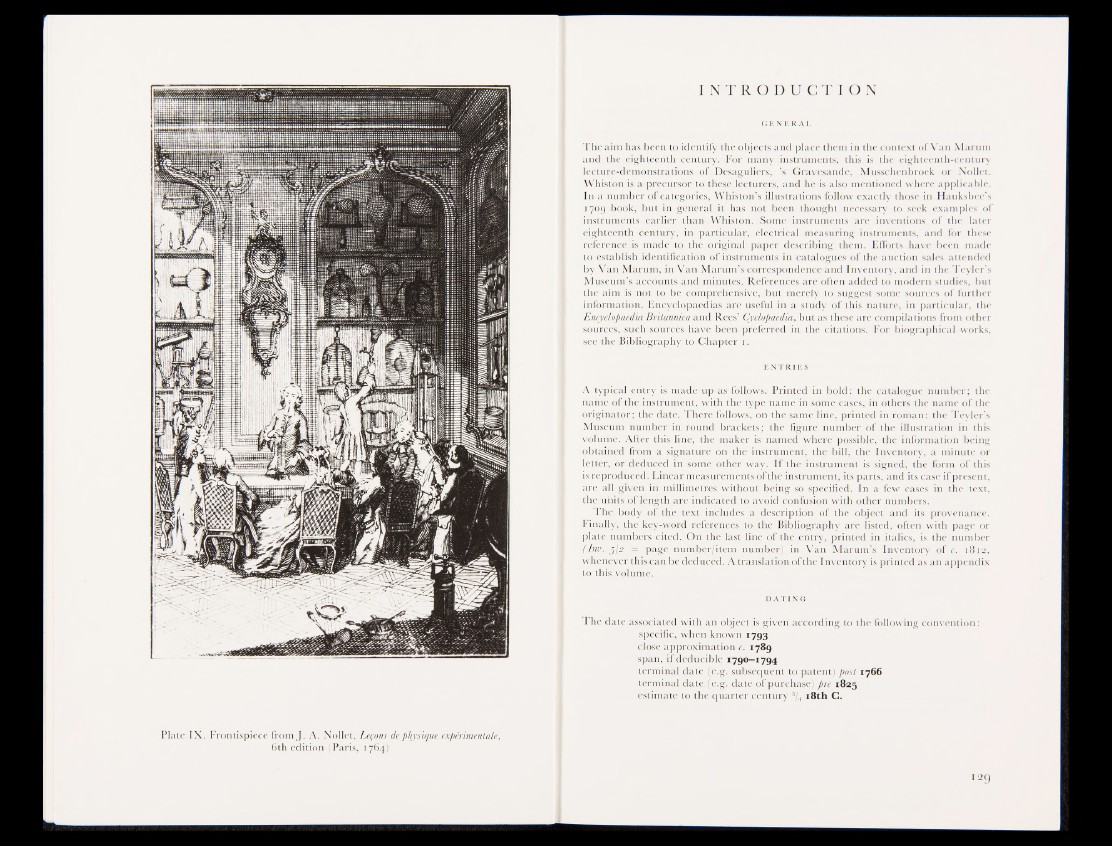
I N T R O D U C T I O N
G E N E R A L
The aim has been to identify the objects and place them in the context of Van Marum
and the eighteenth century. For many instruments, this is the eighteenth-century
lecture-demonstrations of Desaguliers, ’s Gravesande, Musschenbroek or Nollet.
Whiston is a precursor to these lecturers, and he is also mentioned where applicable.
In a number of categories, Whiston’s illustrations follow exactly those in Hauksbee’s
1709 book, but in general it has not been thought necessary to seek examples of
instruments earlier than Whiston. Some instruments are inventions of the later
eighteenth century, in particular, electrical measuring instruments, and for these
reference is made to the original paper describing them. Efforts have been made
to establish identification of instruments in catalogues of the auction sales attended
Hty Van Marum, in Van Marum’s correspondence and Inventory, and in the Teyler’s
Museum’s accounts and minutes. References are often added to modern studies, but
the aim is not to be comprehensive, but merely to suggest some sources of further
information. Encyclopaedias are useful in a study of this nature, in particular, the
Encyclopaedia Britannica and Rees’ Cyclopaedia, but as these are compilations from other
sources, such sources have been preferred in the citations. For biographical works,
see the Bibliography to Chapter 1.
E N T R I E S
A typical entry is made-up as follows. Printed in bold: the catalogue number; the
name of thé instrument, with the type name in some cases, in others the name of the
originator; the date. There follows, on the same line, printed in roman: the Teyler’s
Museum number in round brackets; the figure number of the illustration in this
volume. After this line, the maker is named where possible, the information being
obtained from a signature on the instrument, the bill, the Inventory, a minute or
letter, or deduced in some other way. If the instrument is signed, the form of this
is reproduced. Linear measurements of the instrument, its parts, and its case if present,
are all given in millimetres without being so specified. In a few cases in the text,
the units of length are indicated to avoid confusion with other numbers.
The body of the text includes a description of the object and its provenance.
Finally, the key-word references to the Bibliography are listed, often with page or
plate numbers -cited. On the last line of the entry, printed in italics, is the number
' Inv. 5/2 — page number/item numbeij in Van Marum’s Inventory of c. 1812,
whenever this can be deduced. A translation of the Inventory is printed as an appendix
to this volume.
D A T I N G
The date associated with an object is given according to the following convention :
specific, when known 1793
close approximation c. 1789
span, if deducible 1790—1794
terminal date (e.g. subsequent to patent) post 1766
terminal date (e.g. date of purchase) pre 1825
estimate to the quarter century s/4 18th C.
Plate IX. Frontispiece from J. A. Nollet, Leçons de physique expérimentale,
6th édition (Paris, 1764)